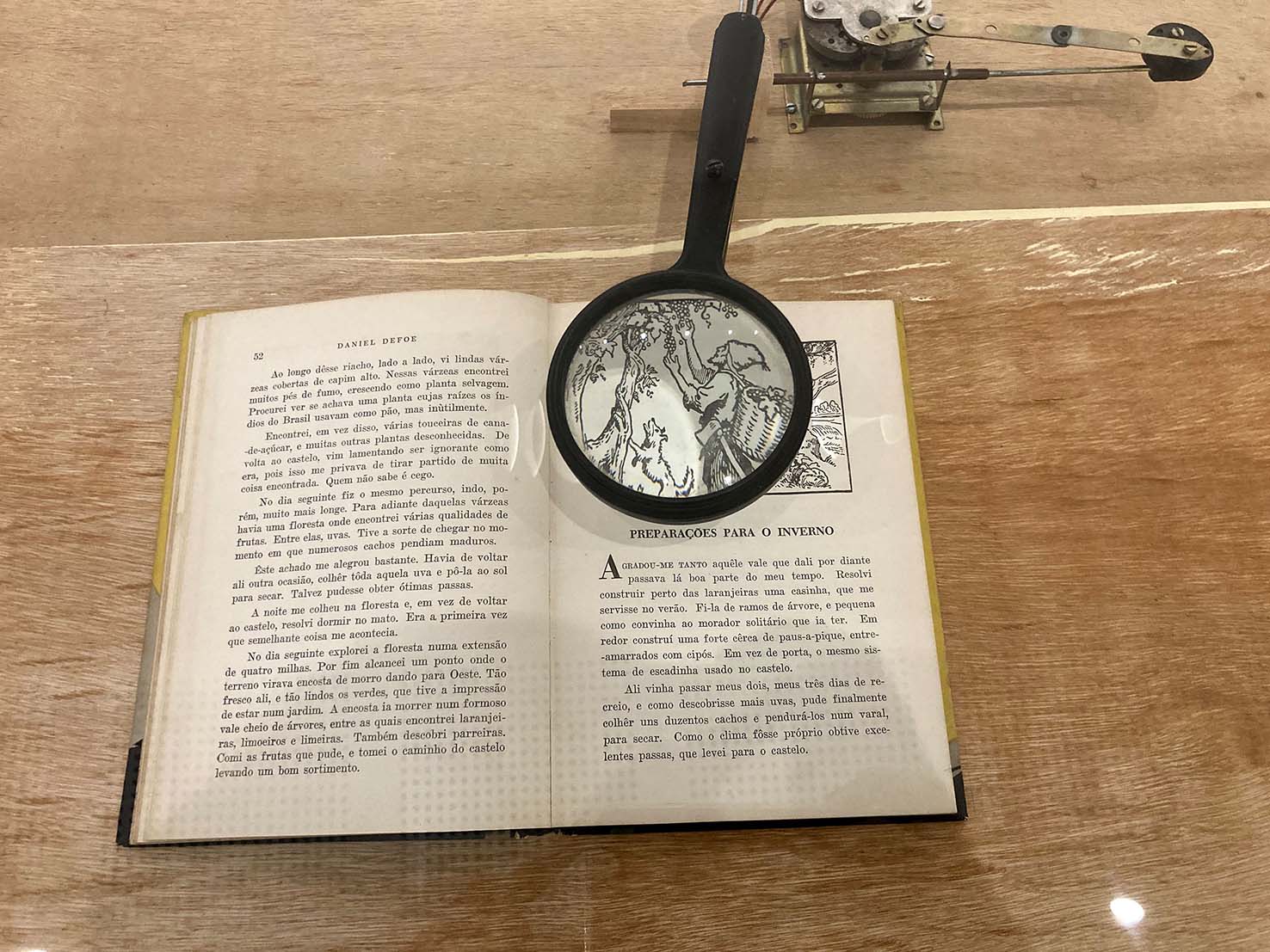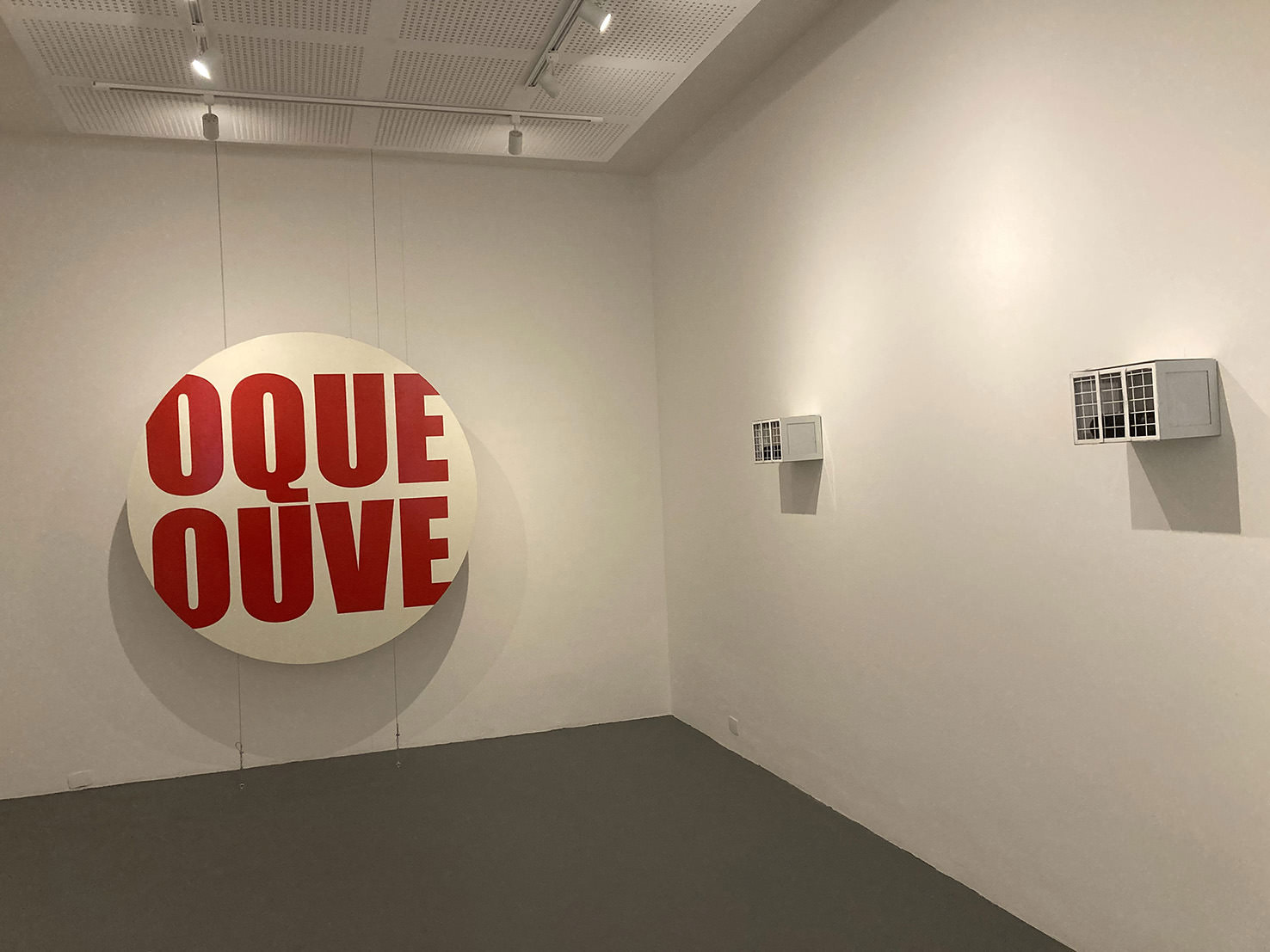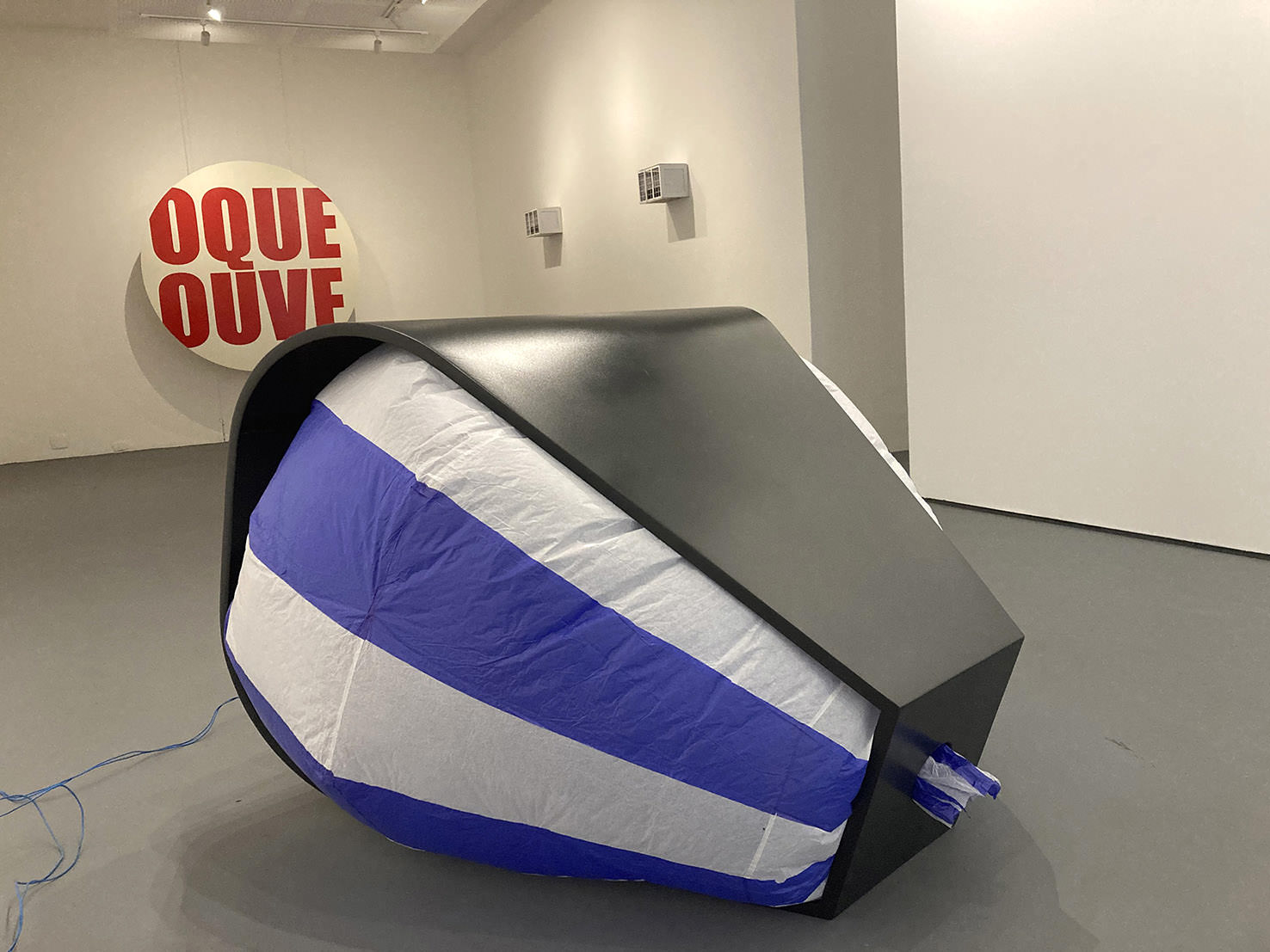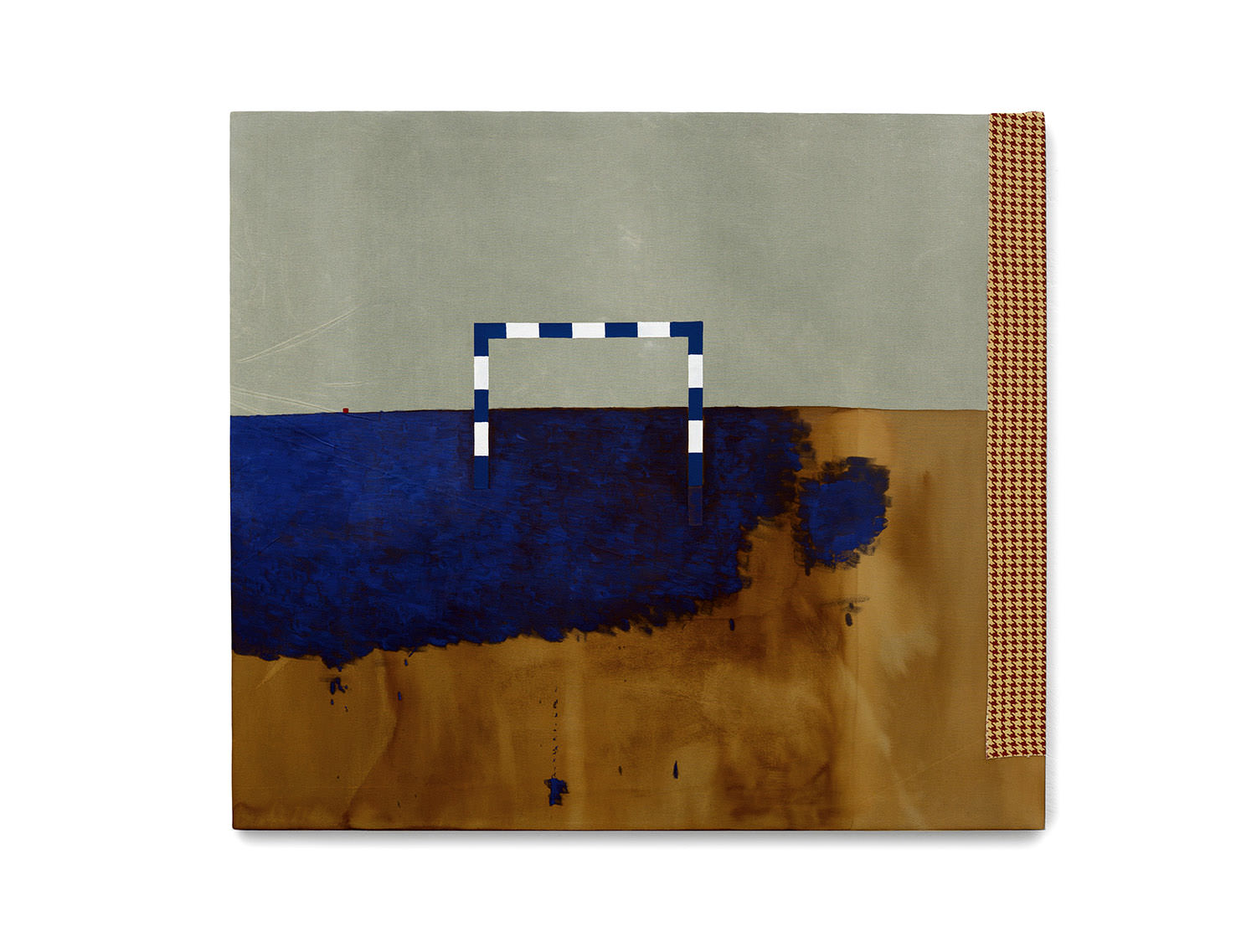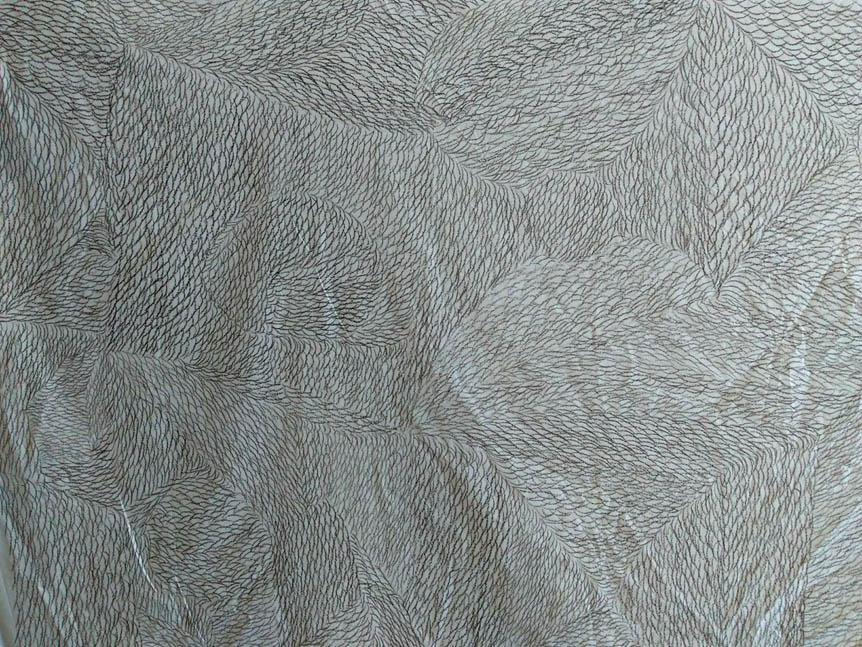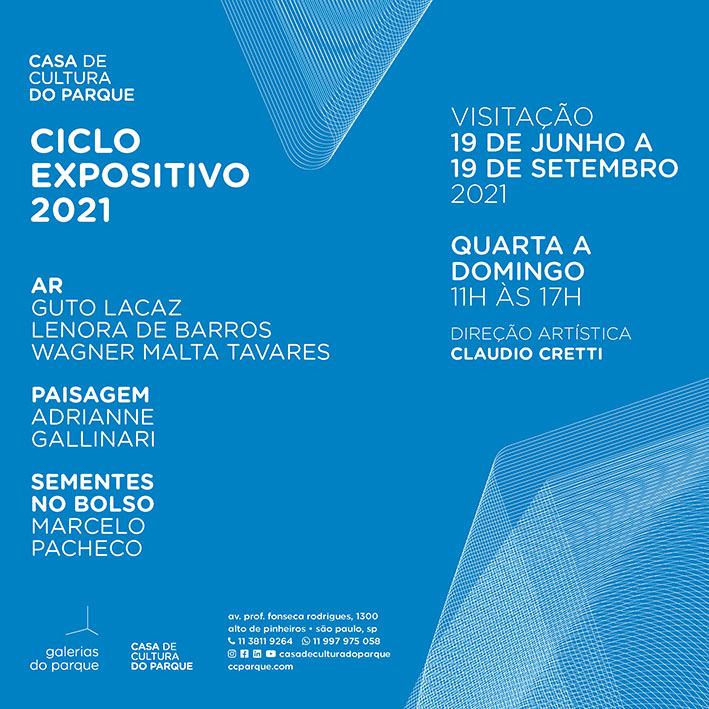on reopening, the House presents two solo exhibitions and a collective with works by Guto Lacaz, Lenora de Barros and Wagner Malta Tavares.
The Park of Culture House, idealized by Regina Pinho de Almeida, starts a new cycle with three new exhibitions in its space. The Park Gallery receive the press conference AIR, with work Guto Lacaz, Lenora de Barros and Wagner Malta Tavares and text Juliana Muniz. The Cabinet Project exposes Seeds in Pocket from Marcelo pacheco with text from Fernanda Pitta and the Project 280 X 1020 Displays Landscape, a drawing of Adrianne Gallinari. The artistic direction is from Claudio Cretti.
- AIR – Guto Lacaz, Lenora de Barros and Wagner Malta Tavares
The unprecedented meeting of three artists from different generations, but with connections that refer to playfulness in his work proposed by Park of Culture House, establishes dialogues that highlight the common point of irony and grace in his production, alluding to the Pop universe, the fun, to contemporaneity.
“Guto Lacaz and Lenora de Barros begin their trajectories between the end of the years 70 and beginning of 80. multiple artists, transit through several languages as the object, the photography, the installation – all present in this exhibition. Although they depart from different poetics in their research, the two artists have several points of convergence that appear frequently in their productions.. Wagner Malta Tavares, dialogues strongly with these issues, creating a contemporary mythology and updating interests that take us back to both classical antiquity and contemporary Pop. Thereby, the artist's look at the work of his colleagues is striking, as if they were part of an entity that thinks about art, acting in sensitivity with fun and mystery, becoming an enigma for the senses of enjoyment in front of the works", explains Claudio Cretti.
In AIR, all works have a certain kinetics. While the series works ELECTRO BOOKS from Guto Lacaz remain static, they can be triggered by audience interaction and set in motion. “Guto Lacaz presents three of its Electro Books (unpublished in São Paulo), in which elegant and synthetic engines (without fairing) set in motion a detail of an illustration from a book from their personal collection. There is no mutilation of the object, who Lacaz consider sacred, but duplication or amplification of an element affectively chosen to move the page before inert. this air engenders, in each Electro Book, a new plot that extends the underlying narrative, that of the book in question", scores Juliana Muniz.
Already in the creations of Lenora de Barros, his primarily sound work results from movement, by the audience, of the static piece in the showroom. In the words of Juliana Muniz "in order to Lenora de Barros, the world changes depending on where we fix our attention. the visitor from AIR listen to the artist's voice chanting the mantra cageano. In this concert for surround speakers, titled what do you hear, ledebe – in the synthetic nickname she uses on Instagram – it is addressed directly and clearly to the public, inviting care for the other and for the current world.”
The work of Wagner Malta Tavares, in its entirety, are powered by electricity, staying in constant motion. "O ar"about the unheard of pasture of the mythical nature of things”, to use a verse fragment from Drummond's World Machine, reverberates throughout the exhibition. He animates the São João sculptures, Ghost and Kneeling Figure, to the extent that it chokes, for your absence, the work Bermuda [aquarium]”, explains Juliana Muniz.
"I think the world changes because we breathe. when we are born, inspires and spends a lifetime exchanging with the world; in this exchange we transform. Then, when dies, people expire, giving back to the world everything that was lived, but in a totally modified way", the firm Wagner Malta Tavares.
“AIR it's not a retinal exposure. Sound, wind, work that moves. This is an exhibition that puts the viewer in motion", define Claudio Cretti
- Cabinet Project – Marcelo pacheco | seeds in pocket
The artist's oil paintings are made on different and different media, mostly the result of their findings in discreet urban mines. The pictorial result tends to a geometric abstraction from the popular universe.
In Fernanda Pitta's view, "for this exhibition, the artist made him enter the studio, Here and there, refuse, carpentry scraps, empty of useful things, that were being picked by Marcelo pacheco in your daily wandering. in this workspace, which is also a kind of haven of things, are reconfigured as you wrap them with colors, rotating their original positions, or combining them with each other.. Some perform infinite and simple columns in their uneven teeth, others suggest keys for a sound instrument, kind of awkward and fun, built for an invisible giant, able to play a silent harmony. Maybe she's a little clumsy too, but therein lies his grace."
- Project 280 x 1020 – Adrianne Gallinari | Landscape
a single drawing, but large, composes the work of Adrianne Gallinari. Although tending to abstraction, the work is a great landscape, unfigured; a landscape not of observation, but 'invented', made in crayons on fabric. An almost obsessive drawing, where the artist builds this immense work with small scratches until it covers the entire area.
In the words of critic Agnaldo Farias, "from the wrist that tames the energy and makes it converge to the fingertips that hold the instrument to the arm that allows the same energy to flow freely as the will to overflow, the artist compiles the gestures, considering that the lightness of the risk coincides with the desire to leave the support - fabric, paper, wall…- speak and that the thick and regular stroke, obsessive to the point of making the figures scramble, creating a thick net, means the opposite, that the sound and design of the sign came about as a result of our desire to calm the sound of the world. "Words are drawings", says the artist, at the same time that it proposes that the images be understood as scriptures.”
SERVICE
PARK GALLERY
Exhibition: AIR
Artists: Guto Lacaz | Lenora de Barros | Wagner Malta Tavares
Presentation text: Juliana Muniz
Number of works: 10
Technique: several
PROJECT 280 x 1020
Exhibition: Landscape
Artist: Adrianne Gallinari
Number of works: 1
Technique: crayons without fabric
DESIGN CABINET
Exhibition: seeds in pocket
Artist: Marcelo pacheco
Presentation Text: Fernanda Pitta
Number of works: 8
Technique: oil without wood
Artistic Direction: Claudio Cretti
Opening: 19 of June, Saturday, from 11:00 to 3:00 pm
Duration: from 19 from June to 19 September 2021
Local: Park of Culture House
Address: Prof Avenue. Fonseca Rodrigues, 1300 – Alto de Pinheiros | Tel.: (11) 3811.9264
Timetables: from wednesday to sunday from 11am – 19h
Free Entry
WebSite ccparque.com
Facebook @casadeculturadoparquesp
Instagram @casadeculturadoparque
YouTube @CasadeCulturadoParque
Sign up to receive Event News
and the Universe of Arts first!
LinkedIn @ park-of-culture-of-the-park
The resumption of the activities of the Casa de Cultura of the Park follows the protocols of the Transition Phase of the São Paulo Plan to control the pandemic, implemented by the state government, in addition to following the protective measures, health and hygiene established by the World Health Organization and Ministry of Health. The number of visitors is still limited to the percentage allowed; temperature measurement is taken at the inlet and alcohol gel devices are positioned at several points in space. The use of a mask is mandatory.
Park of Culture House
Park of Culture House is a plural space that promotes a range of cultural and educational activities, with art exhibitions, shows, lectures, courses, workshops, Among many. Located in front of Villa-Lobos Park, the seat of contemporary architecture and landscaping, has multiple environments for carrying out own and third party activities. As a knowledge forum, offers learning opportunities and creative experiences that transcend disciplinary boundaries and value the expression of cultural experience.
The Park of Culture House has as its main institutional partner the Institute of Contemporary Culture (ICCo), civil society organization of public interest (OSCIP), nonprofit, founded in 2010. Idealized and promoted by Regina Pinho de Almeida, both initiatives are of a socio-educational nature and share the same ideal of expanding access to knowledge in all its breadth.
Juliana Muniz – art criticism, independent curator, journalist specializing in visual arts and master in Communication and Semiotics from the Pontifical Catholic University of São Paulo, where defended, in 2006, the dissertation “pattern break – New paradigms for art criticism in the context of digital culture”, under the guidance of Professor Doctor Giselle Beiguelman. She is communication director at Galeria Luisa Strina, São Paulo. She was editorial director of the art magazine Harper’s Bazaar Art Brasil. She was culture editor at Harper's Bazaar Brasil (2013-2014), deputy editor of seLecT magazine (2011-2012) and reporter and editor of the Folha de S.Paulo newspaper (1999-2010), in addition to having collaborated with several cultural publications., as Contemporary Channel, Well Done!, DASartes e L’Officiel. as art critic, he was part of the critic group of the Project Season of Paço das Artes (2002-2011); maintained a monthly art criticism column, between 2005 and 2007, in Bienart magazine. Directed for three years (2007-2009) the space for experimentation e.d.e.nº343. She was assistant curator of the project Rumos Itaú Cultural Artes Visuais 2001/2003 and performed the curatorships "Ephemeral Solidity" (2019), Garrido Gallery, Recife; “Abstract Atlas” (2016), at the São Paulo Cultural Center, project selected by the Exhibition Program 2016; “Abstraction as Image” (2015), at the TATO Gallery; “Handmade Poetics” (2013), at OMA Gallery; “Everyday invented” (2013), at the Lourdina Jean Rabieh Gallery; “Nonconformist party” (2012), at Oscar Cruz Gallery; “The principle of volatility” (2012), at the Smith Gallery; “photodissolved” (2004), at Sesc Pompéia; “Subjective architectures” (2003), at the Paço das Artes; “To dream home” (2003), at São João da Boa Vista Contemporary Art Week; and “Contemporary Manifests” (2003), at Sesc Vila Mariana, among others. She graduated from the Cásper Líbero Faculty of Social Communication, where did, as graduation work, in 2000, the report book “Untitled – Brazilian art from the decade of 80 a 2000”.
THE ARTISTS
Guto Lacaz (São Paulo, SP, 1948): Multimedia artist, illustrator, designer, designer and set designer. In 1978 wins the “Unusual Object – Applied Art” award (Paço das Artes, São Paulo, SP) and starts his career as a visual artist. In 1982 performs "Modern Ideas", his first solo, at the São Paulo Gallery (São Paulo, SP). In 1983 “Eletro Performance” at the 18th Bienal de São Paulo, SP and in 1986 "Electro Sphere Space", in the exhibition “A Trama do Gosto”. In 1989 the floating composition "Auditorium for sensitive issues", at Ibirapuera Lake and “Cosmos – a walk in infinity”, at MASP (São Paulo, SP). In 2014 participates in the 3rd Bahia Biennial with “Saravá, Kinetic Spiral” for the Lacerda Elevator (Salvador, BA). Inaugurates his second sculpture in public space: “Ulysses, the crazy elephant", at Pedreira do Chapadão Park in Campinas, SP. In 2015 presents the kinetic sculpture “pororoca” in the exhibition “As Margens dos Mares”, at Sesc Pinheiros, the urban intervention “ALEX ALEX”, at CCSP and the performance “Ludo Voo” at Centro Universitário Maria Antonia (São Paulo, SP).
Lenora de Barros (São Paulo, SP, 1953): holds a degree in Linguistics from the University of São Paulo (USP) and began his artistic trajectory in the decade of 1970, time of intense experimentalism in Brazilian art, marked by a strong constructive and avant-garde trend since the years 50. The first works created by Lenora can be placed in the field of visual poetry’ from the concrete poetry movement of the 1950. Words and images were his initial materials. In 1983, LB published the book Onde Se Vê, a set of “poems” quite unusual. Some of them dispensed with the use of words, constructed as photographic sequences, where the artist herself represented different characters in performance acts. This book already announced the transition of Lenora de Barros to the field of visual arts, what ended up happening. Since then, the artist follows her personal path, marked by the use of different languages: video, performance, photography, sound installation and construction of objects. Among the recent exhibitions and activities, the solo exhibition Wanted stands out., Gallery Georg Kargl, Vienna, Austria, 2019; Pisa and Paúra, Millan Gallery, São Paulo-SP, 2017; THAT'S OUR ISSUE, curated by Priscila Arantes at Paço das Artes, São Paulo-SP, Brasil, 2016; one and the other, curated by Gloria Ferreira, PIVÔ, São Paulo-SP, 2014.His work is part of public and private collections in Brazil and abroad: hammer Museum, Los Angeles, USA, Barcelona Museum of Contemporary Art, Daros-Latinamerica, Zurich, Museum of Modern Art of São Paulo (MAM) and Pinacoteca de São Paulo.
Wagner Malta Tavares (São Paulo, SP, 1964)
make use of the video, sculpture, photography, drawing, collage, performance and installation to give vent to its poetics that consists of, in general lines, make visible fundamental aspects that permeate the relationships between people and, between people and things in the world; bring to sensitive experience what is latent. Graduated in Social Communication from FAAP. In 1998 start your work in art. In 1999 joins the group of artists Grupo Olho Seco. In 2001 founds the independent gallery in Santa Cecília 10.20×3,60 which manages up to 2003. Important names who are now part of the contemporary art scene passed through the gallery. Among the works carried out, stand out: the individual Hero at Instituto Tomie Ohtake, Panorama of Brazilian Art at MAM, and exhibitions and international interventions in Belgium, Portugal, Norway, Romania, United States and Italy. Finalist of the Pipa Award of 2014 and winner of the notices: Marcantonio Villaça Award for the acquisition of works, Visual Connections Petrobrás/Funarte and Iberê Camargo Foundation. Resident artist at The Art Institute of Chicago by the Iberê Camargo Scholarship. There are works in the MAM-RJ collections, MAR-RJ, São Paulo State Art Gallery and Bispo do Rosário Museum, RJ, Figueiredo Ferraz Foundation and in several important private collections.
Marcelo pacheco (Campinas, SP, 1984)
Lives and works in São Paulo, SP. He graduated in law from the University of São Paulo in 2009 and defended a master's degree in Economic Law, in 2013, by the same institution. Academic exchange at Université Paris I – Panthéon Sorbonne, in 2008, when he started shooting with an analog camera. He became a public servant at the Court of Justice of the State of São Paulo in 2012. In 2013, settled in a collective studio in São Paulo, where he started to dedicate himself to painting. From 2016, participated in group exhibitions and art salons, among them the Salon of Artists Without Gallery, in January 2017. He held a solo exhibition at the Sancovsky Gallery, in August 2018, curated by Douglas de Freitas. Moved to Massapê Projetos studio (SP), where he participated in the 'Featuring' exhibition, in August 2019, with Thomaz Rosa and Leandro Muniz, inaugurating a work site specific into space. Currently, has been expanding its pictorial research with the production of painted objects and sculptures and works made with collage and sewing of fabrics. Nominated for the Pipa Award 2020.
Adrianne Gallinari (Belo Horizonte, MG, 1965)
Multimedia artist. Between 1984 and 1987, study at Guignard School, along with Rosangela Renno. Starts her artistic performance at this school, developing production in drawing and painting, and experimenting with materials like the ceramics. During this period, know the artists Cao Guimarães and José Bento, among others. Rises in the cultural circuit in the years 1990 with painting and drawing works. The brightly colored painting of the beginning of this decade moves to a drawing with few areas of color, composed of human silhouettes, geometric shapes and words, performed on different supports. Between 1997 and 2003, carries out an itinerant project of drawings on walls in the cities of São Paulo, Buenos Aires, New York, Pontevedra (Spain), Fortress, Pore (Finland) and Belo Horizonte, in which the design is directly related to the architecture of the exhibition site. The word plays a preponderant role in these drawings, generating areas of accumulation similar to the web of lines. In the drawings on paper red series, 2003, the artist resumes the predominant use of color, like in the paintings. In 2006 draws in black ink on fabrics of different sizes, using subtle areas of color. These works have in common lines, figures or geometric shapes that unfold in other images, creating narratives. Movement and narrative are more effectively present in the animations the artist creates on video/DVD, based on a series of sequenced drawings.

